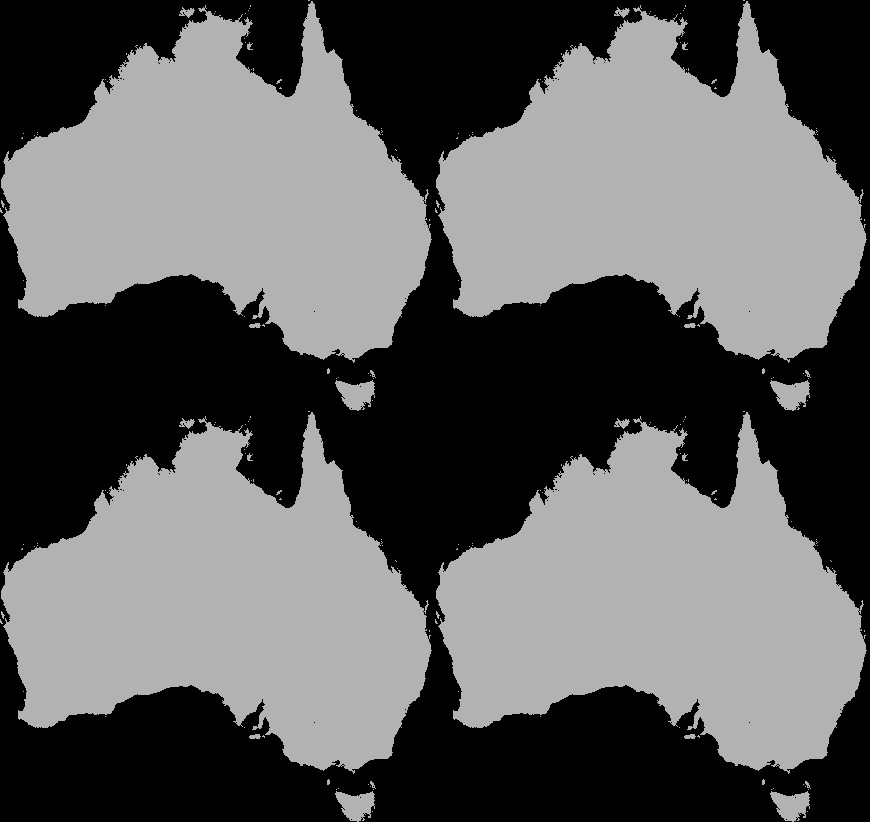DynamicGrids is a generalised framework for building high-performance grid-based spatial simulations, including cellular automata, but also allowing a wider range of behaviours like random jumps and interactions between multiple grids. It is extended by Dispersal.jl for modelling organism dispersal processes.
DynamicGridsGtk.jl provides a simple live interface, while DynamicGridsInteract.jl also has live control over model parameters while the simulation runs: real-time visual feedback for manual parametrisation and model exploration.
DynamicGrids can run rules on single CPUs, threaded CPUs, and on CUDA GPUs. Simulation run-time is usually measured in fractions of a second.
A dispersal simulation with quarantine interactions, using Dispersal.jl, custom rules and the GtkOuput from DynamicGridsGtk. Note that this is indicative of the real-time frame-rate on a laptop.
A DynamicGrids.jl simulation is run with a script like this one
running the included game of life model Life():
using DynamicGrids, Crayons
init = rand(Bool, 150, 200)
output = REPLOutput(init; tspan=1:200, fps=30, color=Crayon(foreground=:red, background=:black, bold=true))
sim!(output, Life())
# Or define it from scratch (yes this is actually the whole implementation!)
life = Neighbors(Moore(1)) do data, hood, state, I
born_survive = (false, false, false, true, false, false, false, false, false),
(false, false, true, true, false, false, false, false, false)
born_survive[state + 1][sum(hood) + 1]
end
sim!(output, life)A game of life simulation being displayed directly in a terminal.
using DynamicGrids
# Define a rule
rule110 = Neighbors(Moore{1,1}()) do data, hood, c, I
l, r = neighbors(hood)
(c + r + c * r + l * c * r) % 2
end
# Initialise
init = zeros(Int, 200)
init[190] = true
output = REPLOutput(init; tspan=1:200, fps=50, style=Braile(), color=:green)
sim!(output, rule110)A one dimensional cellular automata displayed in the terminal line by line
The framework is highly customisable, but there are some central ideas that define how a simulation works: grids, rules, and outputs.
Simulations run over one or many grids, derived from init of a single
AbstractArray or a NamedTuple of multiple AbstractArray. Grids (GridData
types) are, however not a single array but both source and destination arrays,
to maintain independence between cell reads and writes where required. These may
be padded or otherwise altered for specific performance optimisations. However,
broadcasted getindex operations are guaranteed to work on them as if the grid
is a regular array. This may be useful running simulations manually with
step!.
Often grids contain simple values of some kind of Number, but other types are
possible, such as SArray, FieldVector or other custom structs. Grids are
updated by Rules that are run for every cell, at every timestep.
NOTE: Grids of mutable objects (e.g Array or any mutable struct have
undefined behaviour. DynamicGrids.jl does not deepcopy grids between frames as
it is expensive, so successive frames will contain the same objects. Mutable
objects will not work at all on GPUs, and are relatively slow on CPUs. Instead,
use regular immutable structs and StaticArrays.jl if you need arrays. Update
them using @set from Setfield.jl or Accessors.jl, and generally use functional
programming approaches over object-oriented ones.
The init grid/s contain whatever initialisation data is required to start
a simulation: the array type, size and element type, as well as providing the
initial conditions:
init = rand(Float32, 100, 100)An init grid can be attached to an Output:
output = ArrayOutput(init; tspan=1:100)or passed in to sim!, where it will take preference over the init
attached to the Output, but must be the same type and size:
sim!(output, ruleset; init=init)For multiple grids, init is a NamedTuple of equal-sized arrays
matching the names used in each Ruleset :
init = (predator=rand(100, 100), prey=(rand(100, 100))Handling and passing of the correct grids to a Rule is automated by
DynamicGrids.jl, as a no-cost abstraction. Rules specify which grids they
require in what order using the first two (R and W) type parameters.
Dimensional or spatial init grids from
DimensionalData.jl or
GeoData.jl will propagate through the
model to return output with explicit dimensions. This will plot correctly as a
map using Plots.jl, to which shape
files and observation points can be easily added.
Grids containing custom and non-Number types are possible, with some caveats.
They must define Base.zero for their element type, and should be a bitstype for performance.
Tuple does not define zero. Array is not a bitstype, and does not define zero.
SArray from StaticArrays.jl is both, and can be used as the contents of a grid.
Custom structs that defne zero should also work.
However, for any multi-values grid element type, you will need to define a method of
DynamicGrids.to_rgb that returns an ARGB32 for them to work in ImageOutputs, and
isless for the REPLoutput to work. A definition for multiplication by a scalar Real
and addition are required to use Convolution kernels.
Rules hold the parameters for running a simulation, and are applied in
applyrule method that is called for each of the active cells in the grid.
Rules come in a number of flavours (outlined in the
docs). This
allows using specialised methods for different types of rules, ecoding assumtions
about their behaviours that can greatly improve performance through more efficient
use of caches and parallelisation. Rules can be collected in a Ruleset, with some
additional arguments to control the simulation:
ruleset = Ruleset(Life(2, 3); opt=SparseOpt(), proc=CuGPU())Multiple rules can be combined in a Ruleset or simply passed to sim! directly. Each rule
will be run for the whole grid, in sequence, using appropriate optimisations depending
on the parent types of each rule:
ruleset = Ruleset(rule1, rule2; timestep=Day(1), opt=SparseOpt(), proc=ThreadedCPU())Outputs
are ways of storing or viewing a simulation. They can be used
interchangeably depending on your needs: ArrayOutput is a simple storage
structure for high performance-simulations. As with most outputs, it is
initialised with the init array, but in this case it also requires the number
of simulation frames to preallocate before the simulation runs.
output = ArrayOutput(init; tspan=1:10)The REPLOutput shown above is a GraphicOutput that can be useful for checking a
simulation when working in a terminal or over ssh:
output = REPLOutput(init; tspan=1:100)ImageOutput is the most complex class of outputs, allowing full color visual
simulations using ColorSchemes.jl. It can also display multiple grids using color
composites or layouts, as shown above in the quarantine simulation.
DynamicGridsInteract.jl provides simulation interfaces for use in Juno, Jupyter, web pages or electron apps, with live interactive control over parameters, using ModelParameters.jl. DynamicGridsGtk.jl is a simple graphical output for Gtk. These packages are kept separate to avoid dependencies when being used in non-graphical simulations.
Outputs are also easy to write, and high performance applications may benefit
from writing a custom output to reduce memory use, or using TransformedOuput.
Performance of DynamicGrids.jl is dominated by cache interactions, so reducing
memory use has positive effects.
This example implements the classic stochastic forest fire model in a few
different ways, and benchmarks them. Note you will need ImageMagick.jl
installed for .gif output to work.
First we will define a Forest Fire algorithm that sets the current cell to burning, if a neighbor is burning. Dead cells can come back to life, and living cells can spontaneously catch fire:
using DynamicGrids, ColorSchemes, Colors, BenchmarkTools
const DEAD, ALIVE, BURNING = 1, 2, 3
neighbors_rule = let prob_combustion=0.0001, prob_regrowth=0.01
Neighbors(Moore(1)) do data, neighborhood, cell, I
if cell == ALIVE
if BURNING in neighborhood
BURNING
else
rand() <= prob_combustion ? BURNING : ALIVE
end
elseif cell == BURNING
DEAD
else
rand() <= prob_regrowth ? ALIVE : DEAD
end
end
end
# Set up the init array and output (using a Gtk window)
init = fill(ALIVE, 400, 400)
output = GifOutput(init;
filename="forestfire.gif",
tspan=1:200,
fps=25,
minval=DEAD, maxval=BURNING,
scheme=ColorSchemes.rainbow,
zerocolor=RGB24(0.0)
)
# Run the simulation, which will save a gif when it completes
sim!(output, neighbors_rule)Timing the simulation for 200 steps, the performance is quite good. This particular CPU has six cores, and we get a 5.25x speedup by using all of them, which indicates good scaling:
bench_output = ResultOutput(init; tspan=1:200)
julia>
@btime sim!($bench_output, $neighbors_rule);
477.183 ms (903 allocations: 2.57 MiB)
julia> @btime sim!($bench_output, $neighbors_rule; proc=ThreadedCPU());
91.321 ms (15188 allocations: 4.07 MiB)We can also invert the algorithm, setting cells in the neighborhood to burning
if the current cell is burning, by using the SetNeighbors rule:
setneighbors_rule = let prob_combustion=0.0001, prob_regrowth=0.01
SetNeighbors(Moore(1)) do data, neighborhood, cell, I
if cell == DEAD
if rand() <= prob_regrowth
data[I...] = ALIVE
end
elseif cell == BURNING
for pos in indices(neighborhood, I)
if data[pos...] == ALIVE
data[pos...] = BURNING
end
end
data[I...] = DEAD
elseif cell == ALIVE
if rand() <= prob_combustion
data[I...] = BURNING
end
end
end
endNote: we are not using add!, instead we just set the grid value directly.
This usually risks errors if multiple cells set different values. Here they
only ever set a currently living cell to burning in the next timestep. It doesn't
matter if this happens multiple times, the result is the same.
And in this case (a fairly sparse simulation), this rule is faster:
julia> @btime sim!($bench_output, $setneighbors_rule);
261.969 ms (903 allocations: 2.57 MiB)
julia> @btime sim!($bench_output, $setneighbors_rule; proc=ThreadedCPU());
65.489 ms (7154 allocations: 3.17 MiB)But the scaling is not quite as good, at 3.9x for 6 cores. The first method may be better on a machine with a lot of cores.
Last, we slightly rewrite these rules for GPU, as rand was not available
within a GPU kernel. It is now, but it turns out that this method is faster!
and interesting to demonstrate using multiple grids and SetGrid.
This way we call CUDA.rand! on the entire parent array of the :rand grid,
using a SetGrid rule:
using CUDAKernels, CUDA
randomiser = SetGrid{Tuple{},:rand}() do randgrid
CUDA.rand!(parent(randgrid))
endNow we define a Neighbors version for GPU, using the :rand grid values
instead of rand():
neighbors_gpu = let prob_combustion=0.0001, prob_regrowth=0.01
Neighbors{Tuple{:ff,:rand},:ff}(Moore(1)) do data, neighborhood, (cell, rand), I
if cell == ALIVE
if BURNING in neighborhood
BURNING
else
rand <= prob_combustion ? BURNING : ALIVE
end
elseif cell == BURNING
DEAD
else
rand <= prob_regrowth ? ALIVE : DEAD
end
end
endAnd a SetNeighbors version for GPU:
setneighbors_gpu = let prob_combustion=0.0001, prob_regrowth=0.01
SetNeighbors{Tuple{:ff,:rand},:ff}(Moore(1)) do data, neighborhood, (cell, rand), I
if cell == DEAD
if rand <= prob_regrowth
data[:ff][I...] = ALIVE
end
elseif cell == BURNING
for pos in indices(neighborhood, I)
if data[:ff][pos...] == ALIVE
data[:ff][pos...] = BURNING
end
end
data[:ff][I...] = DEAD
elseif cell == ALIVE
if rand <= prob_combustion
data[:ff][I...] = BURNING
end
end
end
endNow benchmark both version on a GTX 1080 GPU. Despite the overhead of reading and writing two grids, this turns out to be even faster again:
bench_output_rand = ResultOutput((ff=init, rand=zeros(size(init))); tspan=1:200)
julia> @btime sim!($bench_output_rand, $randomiser, $neighbors_gpu; proc=CuGPU());
30.621 ms (186284 allocations: 17.19 MiB)
julia> @btime sim!($bench_output_rand, $randomiser, $setneighbors_gpu; proc=CuGPU());
22.685 ms (147339 allocations: 15.61 MiB)That is, we are running the rule at a rate of 1.4 billion times per second.
These timings could be improved (maybe 10-20%) by using grids of Int32 or
Int16 to use less memory and cache. But we will stop here.





